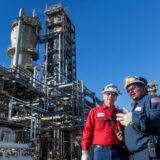ExxonMobil to boost production of ultra-low sulphur fuels in Beaumont refinery
ExxonMobil Corp. plans to increase production of ultra-low sulphur fuels at its Beaumont, Texas, U.S.A., refinery by approximately 40,000 barrels per day (bpd), further strengthening its integrated downstream portfolio while meeting environmental standards.
ExxonMobil’s Beaumont refinery is part of the company’s integrated operations in Beaumont which includes a 345,000 bpd capacity refinery, as well as chemical, lubricants and polyethylene plants. A 20,000 bpd expansion of the refinery’s crude processing capacity, which was announced in 2015, is currently under way.
Construction is scheduled during the second half of 2016 to install a selective cat naphtha hydrofining unit, which uses a proprietary catalyst system to remove sulphur while minimizing octane loss. Start-up of the flexible technology, known as SCANfining, is expected in 2018. Gasoline produced using this technology will meet the U.S. Environmental Protection Agency’s Tier 3 gasoline sulphur specifications.
“ExxonMobil continues to strengthen its portfolio of world-class refining assets,” said Steve Cope, director of North America refining, for ExxonMobil. “This investment further enhances the competitiveness of our U.S. Gulf Coast refineries.”
Installation of the selective cat naphtha hydrofining unit is the facility’s second expansion project in a year, following the announcement of the Beaumont refinery’s capacity expansion in 2015, and demonstrates ExxonMobil’s long-term view and disciplined approach toward advantaged business investments. Beaumont is well positioned to competitively supply high-demand growth markets around the U.S. in the face of a challenging industry environment.
“This specialised unit will improve our product yield, and demonstrates our technology advantage and focus on increasing energy efficiency,” said Fernando Salazar, manager of the Beaumont refinery. “This project represents the largest capital investment in our Beaumont refinery operations in more than a decade, and will benefit the local economy with both temporary and full-time jobs.”













